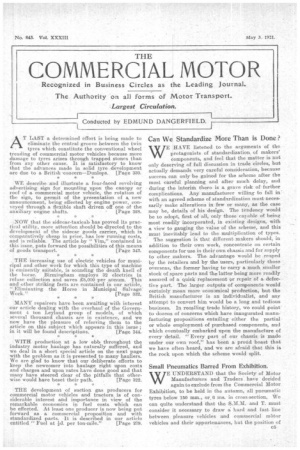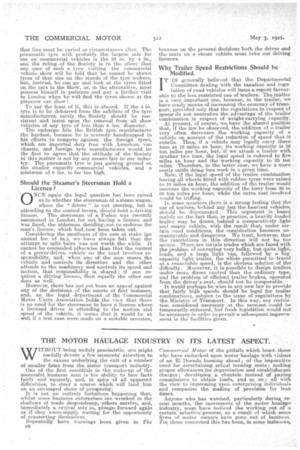Can WO Standardize More Than is Done ?
Page 1

Page 2

If you've noticed an error in this article please click here to report it so we can fix it.
WE HAVE listened to the arguments of the iirotagonists of standardization, of makers' oraponents, and feel that the matter is not only deserving of full discussion in trade. circles, hut actually demands very careful consideration, because success can only be gained for the scheme after the most careful planning, and after much delay, and daring the intern:in there is a grave risk of further complications. Any manufacturer willing to fall in with an agreed scheme of standardization must necessarily make alterations in few or many, as the case may be, details of his design. The tendency would be to adopt, first of all, only those capable of being most readily incorporated, in existing designs, with a view to gauging the value of the scheme, and this must inevitably lead to the multiplication of type-s. The suggestion Is that different makers should, in addition to their own work, concentrate on certain components for use in their awn chassis and for supply to other makers. The advantage would be reaped by the retailers and 'by the users, particularly those aVerseas, the farmer having to carry a mucht smaller stock of spare parts `and the latter being more readily assured of a quick replacement crr repair of a defective part. The larger outputs of components would certainly mean more economical production, but the British manufacturer is an individualist, and any attempt to convert him would be a long and tedious business. In recalling trade history, we could point' to dozens of concerns which have inaugurated manu-' facturing propositions entailing either the partial or whole employment of purchased components, and which eventually embarked upon the manufacture of every detail. "Every part of our chassis-is made under our own roof," has been a. proud boast that we have often -heard, and we are afraid that this is the rock upon which the scheme would split.
Small Pneumatics Barred From Exhibition.
WE UNDERSTAND that the Society of Motor Manufacturers and Traders: have 'decided again to exclude from the Commercial Motor Exhibition, to be held in the autumn, all pneumatic tyres below '150 ram., or, 6 ins, in cross-section. We can quite understand that the S.U.M. and T. must consider it necessary to draw a; hard and fast line between pleasure vehicles 'and commercial mbtor vehicle,s and their appurtenances, but the position of that line must be varied as circumstances alter. The pneumatic tyre with probably the largest. sale for use on commercial vehicles is the 32 in. by 4 in., and the ruling of the Society is to the effect that any user of such a tyre visiting the commercial vehicle show will be told that he cannot. be shown tyres of that size on the stands of the tyre makers, but-, instead, he can go and look at the tyres fitted on the cars in the Show, or, in the alternative, must possess himself in patience and pay a further visit to London when he will find the tyres shown at the pleasure car, show! To say the least of it, this is absurd. If the 4 in. tyre is to be debarred from the exhibits of the tyre manufacturers, surely. the Society should be consistent and insist. upon the removal from all show vehicles of any tyre of less than 6 ins. diameter.
The embargo hits the British tyre manufacturer the hardest, because ho is severely handicapped in his efforts to compete against the foreign tyres, which are imported duty free with American van chassis, and foreign tyre. manufacturers would be the first to agree that the attitude of the. Society in this matter is not by any means fair to our industry. The pneumatic tyre is just gaining ground on the smaller capacity commercial vehicles, and a minimum of 6 ins. is far too high.
Should the Steamer's Steersman Hold a Licence ?
•
0 NCE again the legal question has been raised as to whether the steersman of a steam wagon, where the " driver" is not steering, but is attending to the control levers, should hold a driving licence. The steersman of a Foden was recently sunntioned in London for not having a licence and was fined, the 'alderman clecidingemt to endorse the man's licence, which hadjiow been taken out.
Considering the smallness of the sum at stake alai annual fee of 5s.), we have always. felt that the attempt to split hairs was not worth the while. It cannot be contended otherwise than that the control of a power-driven vehicleon the road involves responsibility, and, when one of the men steers the vehicle and controls its direction and . the other attends to the machinery and controls its speed and motion, that responsibility is shared ; if one requires a driving licence, then equally the other one _does as well. However, there has net yet bee' n an appeal against any of the decisions of the courts of first instance, and, as the legal department of the Commercial Motor Users Association holds the view that there ,is no need for the steersman to have a licence where a licensed driver is attending to the motion and speed of the vehicle, it seems that it. would be as well if a test case were made on a suitable occasion, because on the present decisions both the driver and the mate on a steam vehicle must take out driving licences.
Why Trailer Speed Restrictions Should be Modified.
IT IS generally believed that the Departmental Coatraittee, dealing with the taxation and repm. lation of goad vehicles will issue a report faVenrable to the less restricted use of trailers. The matter is a very important one, because, in the trailer, we have ready means of increasing the, economy of transport, provided only that the regulations in respect of speed: de not neutralize the advantage of the trailer combination in respect of weight-carrying capacity.
At present, of course, we have the absurd position that, if the law be observed, the addition of a trailer very often decreases the working capacity of a vehicle on account of the reduction of speed that it entails. Thus, if a vehicle may legally carry three tons at 12 miles an hour, its working capacity is 36 ton miles per hour, but, if we attach atrailer with another two tens, the legal speed is reduced tofive
miles an hour and the working capacity to 25 ton '
• miles. 'Therefore, in the latter case, we have a more
costly outfit doing less work in a given time.
Now, if the legal speed of the trailer combination having all wheels fitted with rubber tyres were raised to 10 miles an hour, the addition of the trailer would increase the working -capacity of the lorry from 36 to 50 ton miles per hour; while the extra cost involved , would he trilling.
In some quarters there is a strong feeling that the use of trailers,. behind any but the heaviest vehicles, should be discouraged. This argument is based mainly on the,faet that in practice, a heavily loaded trailer may be drawn behind a comparatively light :mid empty vehicle, with the result that, under, certain read conditions, the combinatien becomes unmanageable. and dangerous We. trust, however, that the restrictions -in this direction will not be too severe. There are certain trades which are faced with the problem of conveying very bulky, but quite light, loads, -and a large light van, followed by a bigcapacity light trailer, the whole permitted to travel at a rea.sonable speed, is the obvious solution of the difficulty. Moreover, it is possible to design trailers under more direct control than the ordinary type-, and the problem of efficient trailer brakes, operated from the driver's seat, should not be insuperable. It would perhaps be wise in any net's law toprovide that fairly high speeds should be legal for trailer combinations, subject to the issue of regulations by the Ministry or Transport. In this way, any restriction considered necessary at the 111tonlent could be temporarily enforced, but fresh legislation would not be neeeSsary in order to-permit a subsequent improvement in the facilities given.
































